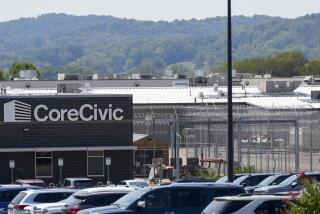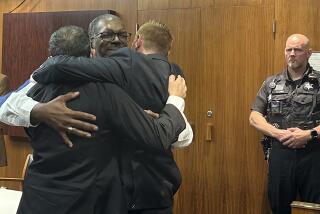8 Prison Guards Are Acquitted in Corcoran Battles
FRESNO — Eight Corcoran prison guards accused of setting up inmate gladiator fights were acquitted Friday of federal civil rights abuses, a resounding verdict that all but ends one of the most troubled chapters in California prison history.
After nine weeks of testimony, jurors deliberated just six hours before clearing the officers of charges that they encouraged rival prisoners to square off and fight--fights that sometimes ended with guards firing deadly shots.
“It was a travesty of justice,” said jury foreman William Lee, posing for photographs with beaming defendants, their wives and lawyers outside the courthouse. “The government’s case made me sick.”
The trial, one of the largest prosecutions ever of state prison guards, was considered a watershed because it followed four years of FBI and newspaper investigations that delved into death, brutality and cover-ups at the prison, which rises out of the cotton fields of the San Joaquin Valley.
Before the verdict was read inside a courtroom packed with relatives, corrections officials and leaders of the guards’ union, the eight officers sat side by side as they had throughout the trial, their backs to the wall and eyes fixed on the jury. Jurors were trying to conceal smiles even before they pronounced their judgment.
The families of the officers burst out crying as U.S. District Judge Anthony Ishii read the long list of not-guilty findings, clearing the defendants of more than 30 counts in all. When Ishii finished the last “not guilty,” one of the defense attorneys slammed his fist onto the table and shouted, “Yeah.” The guards began hugging each other and sobbing.
“I’m proud of my country but ashamed of my government,” said Officer Michael Gipson, 45, comparing his trial with the Salem witch hunts. “They put on a skeleton prosecution. They had 60 witnesses on the list and they called only nine.”
Then Gipson began to laugh. “The [government] started out with nothing and we took them on an E-ticket ride to Disneyland.”
Assistant U.S. Attys. Carl Faller and Jon Conklin declined to discuss the jury’s findings.
“We obviously accept the verdict of the jury. They have the final word in our system,” Faller said. “I do want to assure everyone that this office and the FBI will continue to pursue cases of this type and any violations in our state prison system.”
Four of the defendants--Sgt. John Vaughn, 44; Officer Jerry Arvizu, 32; retired Lt. Douglas Martin, 54; and retired Officer Christopher Bethea, 35--had faced possible life sentences if convicted of conspiring to violate the constitutional rights of inmates. Lt. Truman Jennings, 39, and Officers Timothy Dickerson, 40; Raul Tavarez, 40; and Gipson faced 10-year sentences on lesser charges.
The jury of seven men and five women rejected any argument that the corrections officers were to blame for facilitating the fights as a way for inmates to settle daily scores and for guards to entertain themselves.
During closing arguments, the team of nine defense attorneys paid for by the state blamed vile and violent inmates for the fights and implored jurors to send a message to the federal government for having the audacity to flaunt such a “pathetic, sloppy and shameful” case. Don’t just acquit but acquit in quick time, they urged.
The jury did just that.
“You guys did a hell of a job,” foreman Lee told defense attorney Mark Coleman, shaking his hand as he left the courthouse.
“Did we bury them?” Coleman asked.
“Oh yeah,” Lee said. “It wasn’t even close.”
Juror Dorene Delt, a corrections officer at the Madera County Jail, rejected any suggestion that the short deliberations meant the panel had not given proper weight to the prosecution’s case.
She said the jury twice watched a videotape of one of the prison yard shootings, closely scrutinized duty logs from the unit and pored over other materials.
“It was amazing that [the case] ever got to this point,” she said.
Federal prosecutors conceded months ago that taking on corrections officers in the state’s conservative farm belt, where half a dozen sprawling state prisons light up the night sky and where guards double as Little League coaches, was an uphill climb.
Their worst fears seemed to be realized when Judge Ishii allowed several people to sit on the jury even though they had reason to lean toward the guards’ side, including Delt and a juror whose application to be a state prison guard was pending.
The prosecution was further hampered by the judge’s pretrial ruling barring any testimony about a “code of silence” among corrections officers. The fear of being blackballed and labeled a “rat,” federal prosecutors said during the trial, might have helped the jury understand why at least one former guard called as a government witness backed away from her grand jury testimony. The witness then went out of her way to praise the accused officers in open court.
Both sides agreed that Corcoran State Prison, home to some of the nation’s most notorious killers, including Sirhan Sirhan and Charles Manson, had evolved into a hellish place. From 1989 to 1994, seven inmates were shot to death and 43 were seriously wounded by guards firing assault rifles to keep fistfights from turning deadly--more shootings and deaths than at any other prison in the country.
But it wasn’t until the shooting death of inmate Preston Tate in April 1994 that a handful of guards went to the FBI and the Los Angeles Times.
The guards complained that top corrections officials in Sacramento were clinging stubbornly to a policy of mixing rival inmates in the same small exercise yards, even though that was causing fights and deadly shootings. They alleged that guards and supervisors at the maximum-security prison were using the flawed policy as an excuse to engage in their own perverse games, encouraging the fights and shootings.
But in the end, the government called only one of the whistle-blowers during the trial for limited questioning. And no officials in Sacramento were brought in to explain the workings of the so-called integrated yard policy and whether the accused officers had manipulated that policy by watching one fight after another in Corcoran’s Security Housing Unit.
The accounts of whistle-blowers eventually changed the way Corcoran and other maximum-security prisons operate in California, forcing officials to modify the integrated yard policy and not mix warring prisoners. State legislative hearings in 1998 confirmed a pattern of brutality at Corcoran, and an independent panel found that nearly 80% of the shootings were unjustified and never fully investigated by the state.
Since the whistle-blowing guards took their case to the public, no inmate has been killed at Corcoran.
“I can sleep a lot better now,” California Department of Corrections Director Cal Terhune said after the verdict. “I have consistently indicated support for these officers, because I spent a lot of time reviewing the case and documents and I could just never see they were responsible for any misconduct.”
*
Times staff writer James Rainey and correspondent Jacalyn Thornton contributed to this story.
More to Read
Sign up for Essential California
The most important California stories and recommendations in your inbox every morning.
You may occasionally receive promotional content from the Los Angeles Times.










